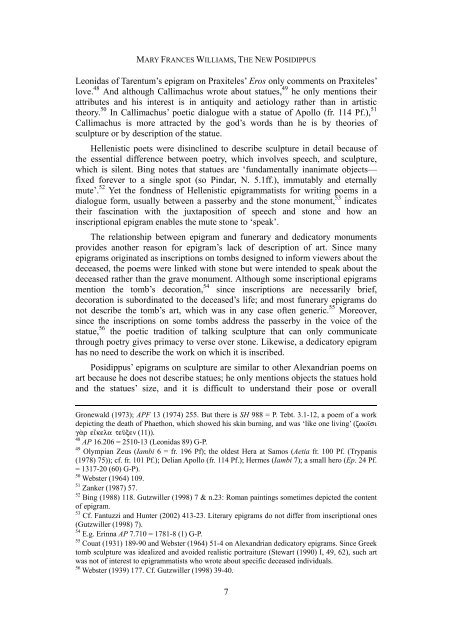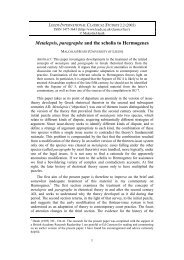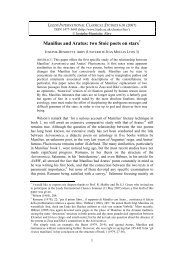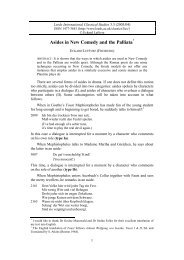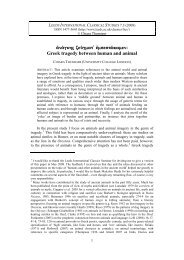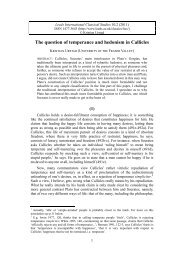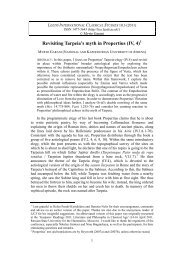The New Posidippus - Leeds International Classical Studies
The New Posidippus - Leeds International Classical Studies
The New Posidippus - Leeds International Classical Studies
Create successful ePaper yourself
Turn your PDF publications into a flip-book with our unique Google optimized e-Paper software.
MARY FRANCES WILLIAMS, THE NEW POSIDIPPUS<br />
Leonidas of Tarentum’s epigram on Praxiteles’ Eros only comments on Praxiteles’<br />
love. 48 And although Callimachus wrote about statues, 49 he only mentions their<br />
attributes and his interest is in antiquity and aetiology rather than in artistic<br />
theory. 50 In Callimachus’ poetic dialogue with a statue of Apollo (fr. 114 Pf.), 51<br />
Callimachus is more attracted by the god’s words than he is by theories of<br />
sculpture or by description of the statue.<br />
Hellenistic poets were disinclined to describe sculpture in detail because of<br />
the essential difference between poetry, which involves speech, and sculpture,<br />
which is silent. Bing notes that statues are ‘fundamentally inanimate objects—<br />
fixed forever to a single spot (so Pindar, N. 5.1ff.), immutably and eternally<br />
mute’. 52 Yet the fondness of Hellenistic epigrammatists for writing poems in a<br />
dialogue form, usually between a passerby and the stone monument, 53 indicates<br />
their fascination with the juxtaposition of speech and stone and how an<br />
inscriptional epigram enables the mute stone to ‘speak’.<br />
<strong>The</strong> relationship between epigram and funerary and dedicatory monuments<br />
provides another reason for epigram’s lack of description of art. Since many<br />
epigrams originated as inscriptions on tombs designed to inform viewers about the<br />
deceased, the poems were linked with stone but were intended to speak about the<br />
deceased rather than the grave monument. Although some inscriptional epigrams<br />
mention the tomb’s decoration, 54 since inscriptions are necessarily brief,<br />
decoration is subordinated to the deceased’s life; and most funerary epigrams do<br />
not describe the tomb’s art, which was in any case often generic. 55 Moreover,<br />
since the inscriptions on some tombs address the passerby in the voice of the<br />
statue, 56 the poetic tradition of talking sculpture that can only communicate<br />
through poetry gives primacy to verse over stone. Likewise, a dedicatory epigram<br />
has no need to describe the work on which it is inscribed.<br />
<strong>Posidippus</strong>’ epigrams on sculpture are similar to other Alexandrian poems on<br />
art because he does not describe statues; he only mentions objects the statues hold<br />
and the statues’ size, and it is difficult to understand their pose or overall<br />
Gronewald (1973); APF 13 (1974) 255. But there is SH 988 = P. Tebt. 3.1-12, a poem of a work<br />
depicting the death of Phaethon, which showed his skin burning, and was ‘like one living’ (zwo‹si<br />
g¦r e‡kela teàxen (11)).<br />
48 AP 16.206 = 2510-13 (Leonidas 89) G-P.<br />
49 Olympian Zeus (Iambi 6 = fr. 196 Pf); the oldest Hera at Samos (Aetia fr. 100 Pf. (Trypanis<br />
(1978) 75)); cf. fr. 101 Pf.); Delian Apollo (fr. 114 Pf.); Hermes (Iambi 7); a small hero (Ep. 24 Pf.<br />
= 1317-20 (60) G-P).<br />
50 Webster (1964) 109.<br />
51 Zanker (1987) 57.<br />
52 Bing (1988) 118. Gutzwiller (1998) 7 & n.23: Roman paintings sometimes depicted the content<br />
of epigram.<br />
53 Cf. Fantuzzi and Hunter (2002) 413-23. Literary epigrams do not differ from inscriptional ones<br />
(Gutzwiller (1998) 7).<br />
54 E.g. Erinna AP 7.710 = 1781-8 (1) G-P.<br />
55 Couat (1931) 189-90 and Webster (1964) 51-4 on Alexandrian dedicatory epigrams. Since Greek<br />
tomb sculpture was idealized and avoided realistic portraiture (Stewart (1990) I, 49, 62), such art<br />
was not of interest to epigrammatists who wrote about specific deceased individuals.<br />
56 Webster (1939) 177. Cf. Gutzwiller (1998) 39-40.<br />
7


